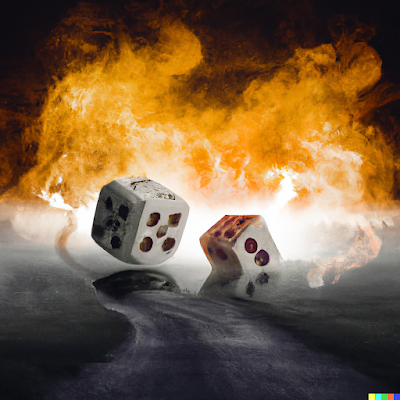Physical dice are great. They feel good to roll.
But they have drawbacks. They can stop the action. The DM may have to pause or artificially slow the narration and adjudication of events while waiting on a roll. New players often roll slowly or mix up the dice.
Some games condense the number of rolls. The Bastionland family of games drops to-hit rolls; all attacks hit, and characters roll for damage. PBtA games resolve a lot of fiction in a single roll.
In other systems, we can still condense the process of rolling. I always encourage my players to roll damage at the same time as an attack roll (and it’s almost always combat we’re talking about when dice are slowing down the action).
Can we add more information density to a roll? At the simplest level, that’s like a rolling 2d8 for Thogdar’s flaming longsword, with a black die representing the blade’s damage and a red die representing the fire damage. The overloaded encounter die is another example of adding information density.
So how can we pack more information density into those rolls? A good way is treating where the dice land as another output, in addition to what their faces show.
Roll on the Map
Are you using a battle map or an exploration map? Roll the dice directly onto it. This is certainly not an original idea – it’s been featured in more than one game, although I’m blanking on which ones (and welcome comments to that effect).
But it’s great. Burning meteors falling from the sky? Roll some d12s onto the map. The spot where each die lands is an impact point, and the result on each die is the radius of the blast of fiery debris.
If instead of meteors, we have artillery fire zeroing in on the characters, adjust accordingly. On the first round, drop the dice from four feet above the table, and then halve that elevation each subsequent round. As you get closer to the table, you’ll become more accurate. The need to win or escape the battle will not be lost on any player at the table.
Roll on the Character Sheet
When a monster hits a character, the DM rolls the damage die on the player’s character sheet, interpreting the outcome of the attack based on where the die lands. On their equipment? Something might have just been smashed. On their dexterity score? It could be an injury inflicting a temporary penalty to that attribute.
Tabletop Shuffleboard
Incorporate a system like tabletop shuffleboard directly in the game. Draw out a diagram on a large piece of paper and label some big triangles and rectangles. The labels could indicate changes in fictional positioning, environmental effects, chase obstacles, whatever we want. When the DM and the players roll dice for anything, they try to roll onto desirable places on the table. As in shuffleboard, croquet-like impacts can change opponents’ fortunes. Clearly identifiable color-coded dice are a must here.
Downsides and Caveats
Clearly, these ideas mostly only work in physical spaces. Some VTTs can simulate die rolling, but it’s not a function of player skill.
Rolling on a battle map requires, well, using a battle map. I usually prefer theater of the mind for most combat. Rolling on character sheets requires each player to have a physical piece of paper in front of them, by no means typical of many tables.
These are also physical dexterity games. Not everyone wants that in a game that otherwise doesn’t test physical skills, and differences in capability, ability, or skill could pull attention away from the fictional action. Consult with your players before incorporating these ideas in a game.




No comments:
Post a Comment